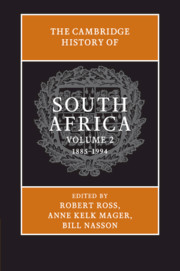Book contents
- Frontmatter
- Contents
- Contributors
- Acknowledgments
- Note on references
- Introduction
- 1 South Africa and South Africans: Nationality, Belonging, Citizenship
- 2 Imperialism, Settler Identities, and Colonial Capitalism: The Hundred-Year Origins of the 1899 South African War
- 3 Class, Culture, and Consciousness in South Africa, 1880–1899
- 4 War and Union, 1899–1910
- 5 South Africa: The Union Years, 1910–1948 – Political and Economic Foundations
- 6 South African Society and Culture, 1910–1948
- 7 The Apartheid Project, 1948–1970
- 8 Popular Responses to Apartheid: 1948–c. 1975
- 9 Resistance and Reform, 1973–1994
- 10 The Evolution of the South African Population in the Twentieth Century
- 11 The Economy and Poverty in the Twentieth Century
- 12 Modernity, Culture, and Nation
- 13 Environment, Heritage, Resistance, and Health: Newer Historiographical Directions
- Statistical Appendix
- Bibliography
- Index
- References
10 - The Evolution of the South African Population in the Twentieth Century
Published online by Cambridge University Press: 28 July 2011
- Frontmatter
- Contents
- Contributors
- Acknowledgments
- Note on references
- Introduction
- 1 South Africa and South Africans: Nationality, Belonging, Citizenship
- 2 Imperialism, Settler Identities, and Colonial Capitalism: The Hundred-Year Origins of the 1899 South African War
- 3 Class, Culture, and Consciousness in South Africa, 1880–1899
- 4 War and Union, 1899–1910
- 5 South Africa: The Union Years, 1910–1948 – Political and Economic Foundations
- 6 South African Society and Culture, 1910–1948
- 7 The Apartheid Project, 1948–1970
- 8 Popular Responses to Apartheid: 1948–c. 1975
- 9 Resistance and Reform, 1973–1994
- 10 The Evolution of the South African Population in the Twentieth Century
- 11 The Economy and Poverty in the Twentieth Century
- 12 Modernity, Culture, and Nation
- 13 Environment, Heritage, Resistance, and Health: Newer Historiographical Directions
- Statistical Appendix
- Bibliography
- Index
- References
Summary
Introduction
Changes in core demographic variables – population size and composition, fertility, mortality and migration – can indicate a great deal about the development of a society. For a start, they indicate the status of the demographic transition, the move from a demographically wasteful regime of high fertility and high mortality rates to an efficient one of low fertility and mortality. No society reaches developed status without passing through the demographic transition. To the core demographic variables, fertility and mortality, can be added marital status and household size, education, language most often spoken at home, religion, labour market status, urbanisation and inequality, and poverty. Each of these variables further illuminates social conditions.
- Type
- Chapter
- Information
- The Cambridge History of South Africa , pp. 492 - 517Publisher: Cambridge University PressPrint publication year: 2011



